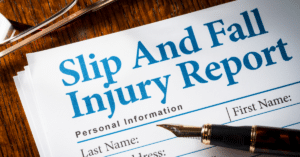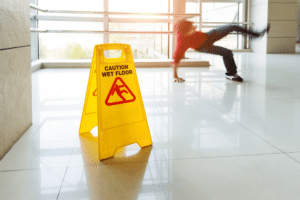DETERMINING LIABILITY
SIDEWALK MAINTENANCE
The first factor is determining who is responsible for maintaining the sidewalk. Most public sidewalks are easements by city or county governments. Often, the entity responsible for maintaining the sidewalk is a local municipality.
However, any number of circumstances can complicate matters. Adjacent property owners may damage a sidewalk during landscaping. Business owners may place objects on the sidewalk that create a tripping hazard. Water runoff from a building can cause concrete to deteriorate and buckle. Determining who maintains the sidewalk may not give you the clear answer you need.
When it comes to falls, there is no such thing as “automatically at fault.” There is a common misperception out there that if you fall on somebody else’s property, the owner is automatically at fault. This is not the case.
Owners are only held at fault if you prove that they were negligent in some very specific ways. The legal terminology used can include phrases like:
- A “dangerous or defective condition.” This means that the condition creates a substantial, as opposed to a trivial, risk of injury.
- The condition is “not open and obvious.” We all must take care and pay attention to our surroundings when we are walking out in public. If a hazard is easily seen and not hidden from view, the law expects you to avoid it.
- The owner “knew or should have known” about the dangerous condition. Personal injury lawyers want to know how long a defective condition has been present, whether the owner knew about or had received notice of the defect, and how the defect got there in the first place.
WEATHER CONDITIONS
When inclement weather happens, it happens to all of us. State law does not require property owners to remove the natural accumulation. In many cases, if a property owner does nothing at all, they still have no liability for any injuries caused by the natural accumulation of ice and snow on their sidewalk.
Sometimes, however, local ordinances or contracts impose such a duty on a landowner. For example:
- The lease may obligate a landlord to provide tenants with reasonable ice and snow removal.
- Local ordinances may require businesses to remove snow if they are open during inclement weather
However, whether there is a duty to remove snow and ice or not, a property owner who makes the situation worse, through action or neglect, may face legal troubles for subsequent injuries. One example would be a gutter in poor repair that drains water onto a sidewalk, where it freezes into ice.
Public sidewalks mean shorter timeframes to act. The law treats government entities differently than private property owners. This difference can have an enormous (and detrimental) impact on your injury claim.
- The “90-day rule” in Missouri: Although the statute of limitations in Missouri for a personal injury claim is five years, Missouri law requires an injured person to notify a city or municipality of the time, place, and circumstances of the injury, as well as the person’s intention to claim damages from the city. This notice must be in writing and be made within 90 days of the injury. If the 90-day deadline is missed, plaintiffs are often barred from any lawsuit at all.
- The one-year statute of limitations in Illinois: Most personal injury claims in Illinois have a two-year statute of limitations. However, if the defendant is a municipality, the injured party only has one year.
Sidewalk cases can become very complicated very quickly. The best way to answer the question, “Do I have a case?” is to contact an experienced personal injury lawyer as soon as you reasonably can after you are injured. They can help you determine whether you have a claim and what the best course of action will be moving forward.








